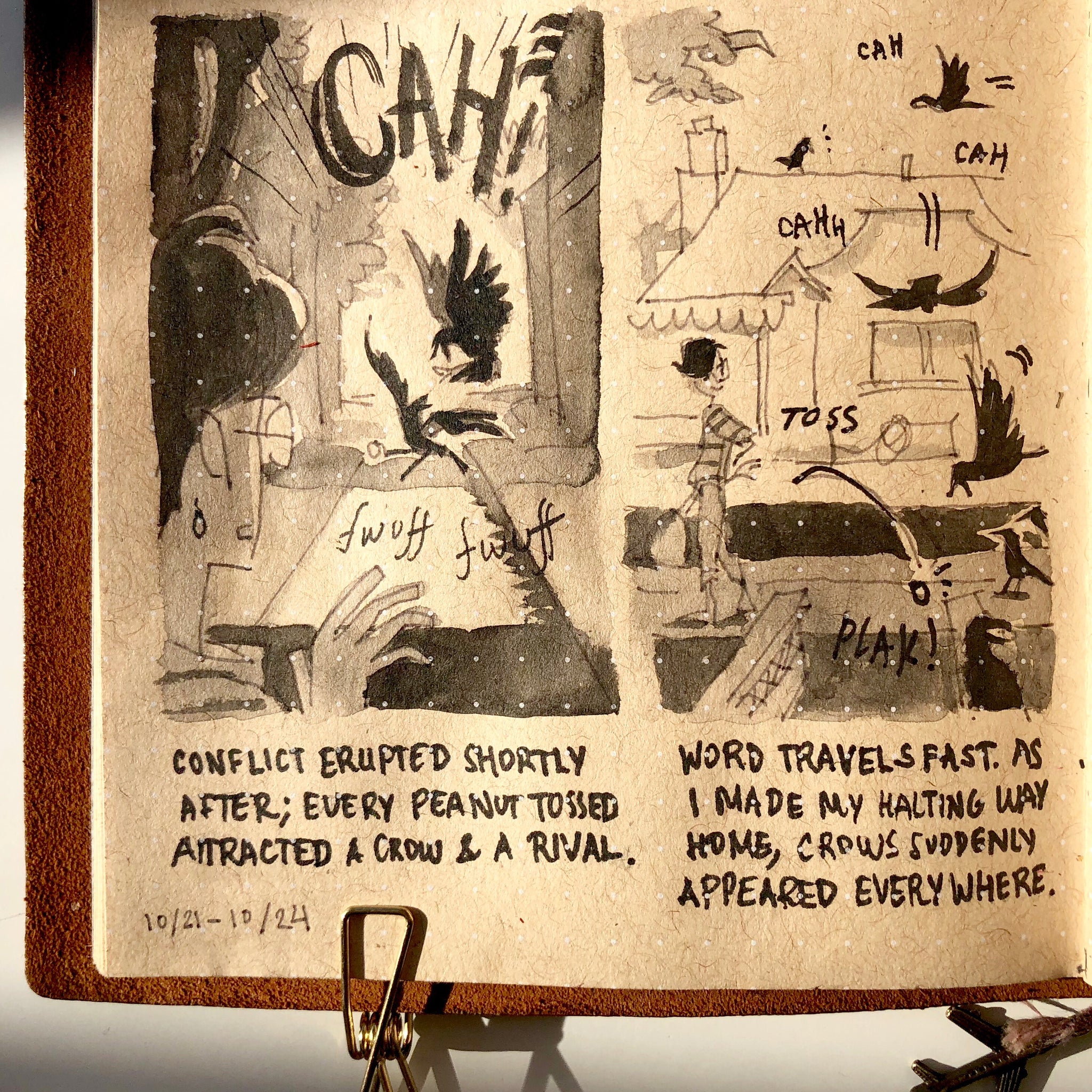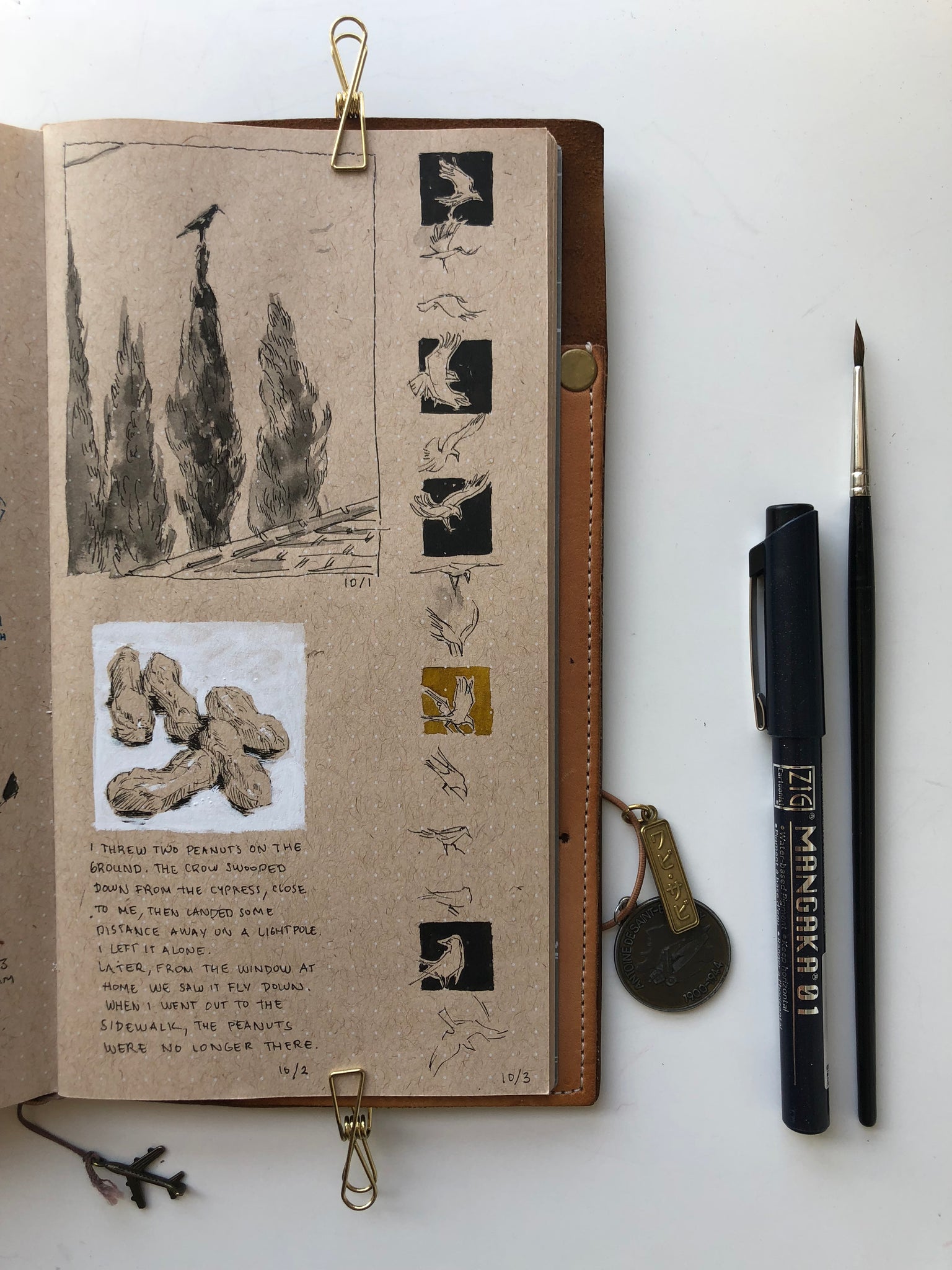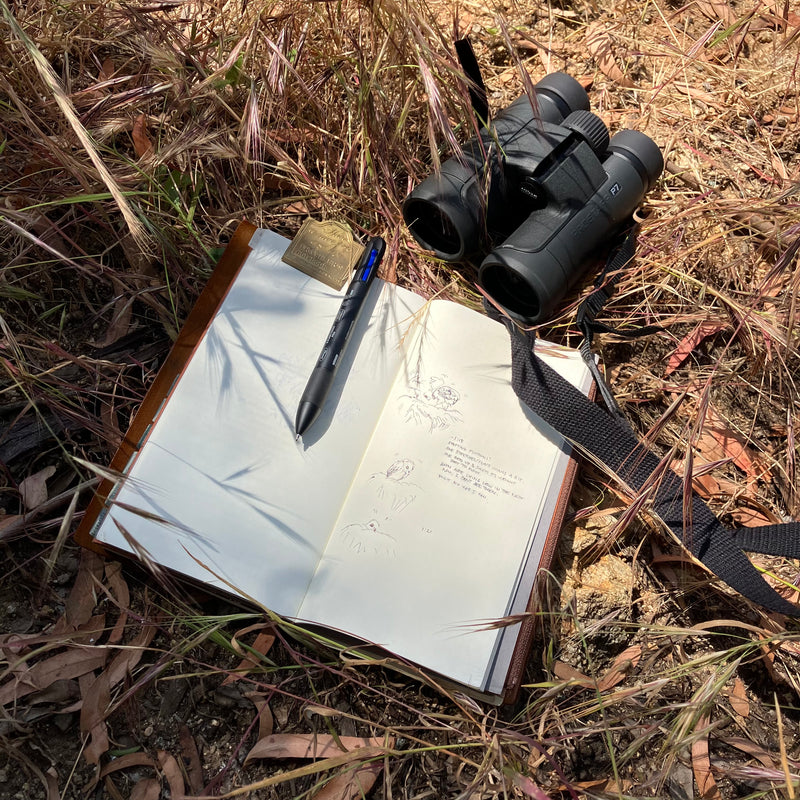It’s a hot spring day in Los Angeles and I’ve just parked my car on a scrubby, wooded hillside. My TN, a pen and a pair of binoculars come out with me. I leave behind my sweater and turn my phone on silent. Nobody call me, nobody talk to me; I’m here for the birds.
Specifically, I’m here for red-tailed hawks. I skirt around the sycamore tree their nest is in, taking a roundabout way up another slope behind it. It’s best not to gawk or be too direct as you approach: hawks can see you long before you can see them, and you want them to see a person who’s planning on minding their own business. Actually, as I walk, one of the adult hawks leaves the nest and soars upwards, circles once, then speeds away to the northeast. These particular hawks don’t seem to mind humans being around. Still, best to err on the polite side. There have been stories of people who, raptor-watching too blatantly, irritated the birds and get dive-bombed. Even worse, there’s always the risk that the birds will become so stressed that they’ll abandon the nest.
The top of the hill is eye-level with the top of the sycamore. The nest itself is obscured by foliage (and from the nest’s point of view, so am I). But if I sit partway down the hill amongst sun-crunched reeds and aim my binoculars through a gap between crisscrossing branches, I can look almost right into the nest. What I see:

Two healthy red-tailed hawk chicks, already big and active, stretching their wings and climbing over each other. Their eyes and beaks are already as fierce-looking as their parents, but their heads and shoulders are still fuzzy and grey. I keep quiet as I focus and re-focus the binoculars, but inside I’m so excited I could yelp—seeing the chicks on this day is the culmination of several months of nest monitoring.



Back in January, I started volunteering for the Los Angeles Raptor Study. “Raptor” comes from Latin for, “to seize or grasp”, referring here to the talons birds of prey use to catch their food. Gathering data on the health of these birds’ nests and chicks over the years helps scientists understand how they are adapting to human activity in urban areas. At first I hesitated to apply, because I’m neither a biologist nor a hardcore birdwatcher (though it turns out that you don’t really need to be either to start; a respect for and interest in raptors is enough, along with transport and a small time commitment–anything else you need to know provided in training). My only prior experience with birding was keeping a “crow diary” of sorts in my TN.

In my old neighborhood, I’d noticed that a family of crows would return to the same pine tree at around the same September-ish window of time every year, so I’d commemorate it once a year with a sketch. But with nature, the more you look, the more you notice. Soon I was constantly glancing out the windows to see what the crows were doing throughout the year, watching them use the electricity poles and rooftops of the neighborhood like a jungle gym, stash food in truly unlikely locations, tussle with mockingbirds and, one year, raise a family in a palm tree. There was no shortage of interesting behavior to record in my notebooks.






In a way, becoming interested in hawks was the natural next step. I became more aware of them because I often saw them being chased by crows. Their piercing “KEEEE!” cries and dazzling, dexterous flying always stopped me in my tracks. The more I looked out for hawks, the more I realized that they’re almost as ubiquitous as crows are in urban spaces. Here I most often see them perched on light poles along the freeways, or hovering on updrafts of wind near hills and tall buildings. My partner has gotten much better than me at spotting them, and can quickly detect their movements in the trees they favor.
Whether it’s a crow intrepidly opening up an abandoned paper bag of fast food or a Cooper’s hawk staring me down as it digs in to its own, more…organic lunch, I feel glad to see these birds doing well—a reminder that even in a city as sprawling and developed as this, we’re sharing space with nature. It’s both reassuring and responsibility. Part of the reason this study focuses on hawks is because they are at the top of our local urban wildlife food chain: if something goes wrong with them, it can indicate problems elsewhere in the ecosystem. For example, finding a previously healthy hawk dead can lead to the discovery that it was poisoned by eating a rat which had eaten rodenticide, which can lead to holding the nearby building responsible for finding a different solution for its pest control. We can be better neighbors than that. I think of something my colleague Melanie Gillman said in their (awesome!) zine about fruit foraging in the wild: “Gratitude will change how you forage…done well, foraging is not a burden on your local ecosystem, but a benefit to it. Many plants thrive best with human involvement, not in our absence.” I found this to be such a wise and lovely thought in a world where the relationship between humans and nature so often seems dystopian beyond repair.
I watch the two hawk chicks, sketching and jotting down a few notes on the condition of the nest and the surrounding area. I’ll summarize these notes in a data sheet for the study later. I’m near-inseparable from my Traveler’s Notebook and would probably choose to do this documentation by hand anyway, but one of the reasons I draw rather than take photos is that it’s less likely to catch the birds’ attention and disturb them. So I freeze when one of the chicks adopts a strange pose: its body stays still and in profile, but its face swivels around to face my direction, its head and neck clicking into place a just few, slightly uncanny jots over from where you would normally expect its head and neck to be. It squints, opens its eyes wide and round, then squints again. Moments pass. Soon, it returns to its normal fluffy state. Once I’m sure it’s not alarmed, I close my notebook, get up quietly and head back to the car. If the hawk chick did see me, I hope it understands I am minding my business, and I’m grateful for the drawings and the glimpse of its young, sunny life.

—
Text and photos by: A.C. Esguerra
Where to find A.C. : instagram @blueludebar
Read other stories by A.C. : Here
Links:
- LA Raptor Study - Friends of Griffith Park
- Fruit for Free: A Foraging Zine by Melanie Gillman
- Audubon’s Guide to Ethical Bird Photography and Videography
Bk Artifacts Featured:
- Traveler's Notebook | Camel
- [BK x TRC] JIYU Monthly Planner
- 019 // Four Functions Pen
- [BK x TRC] Journey is the Destination Insert
- TN / 030 / Brass Clip


I really loved this! I too, am a bird watcher. I live in Coastal Georgia, so we have many beautiful birds to watch. Including Hawks and crows. I love all of your sketches and doodles. It has inspired me to do the same. Thank you, this was lovely!